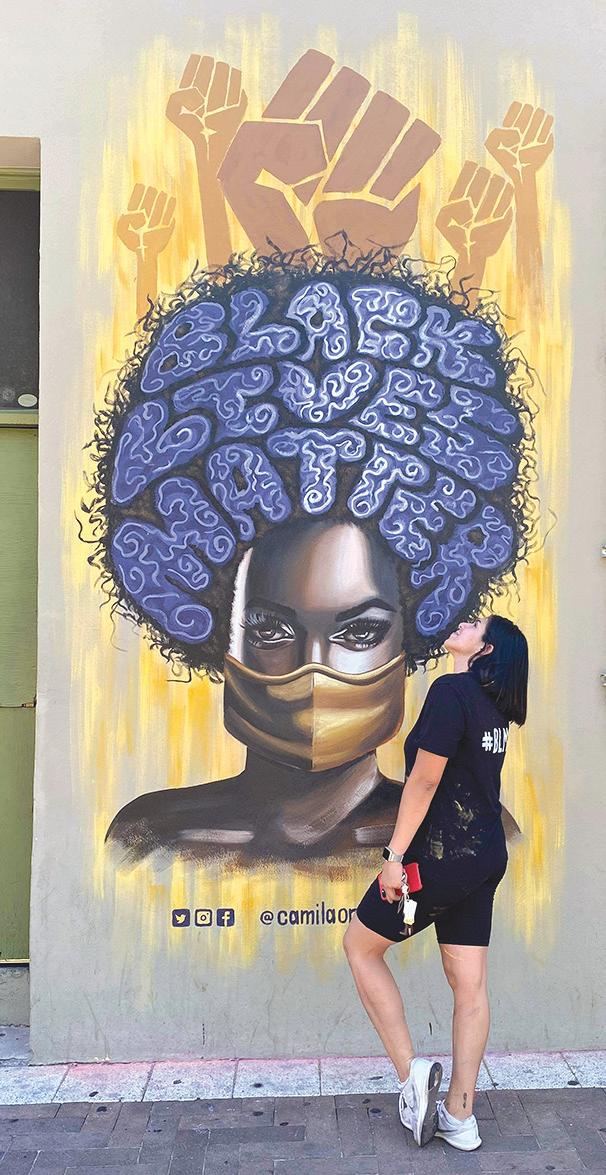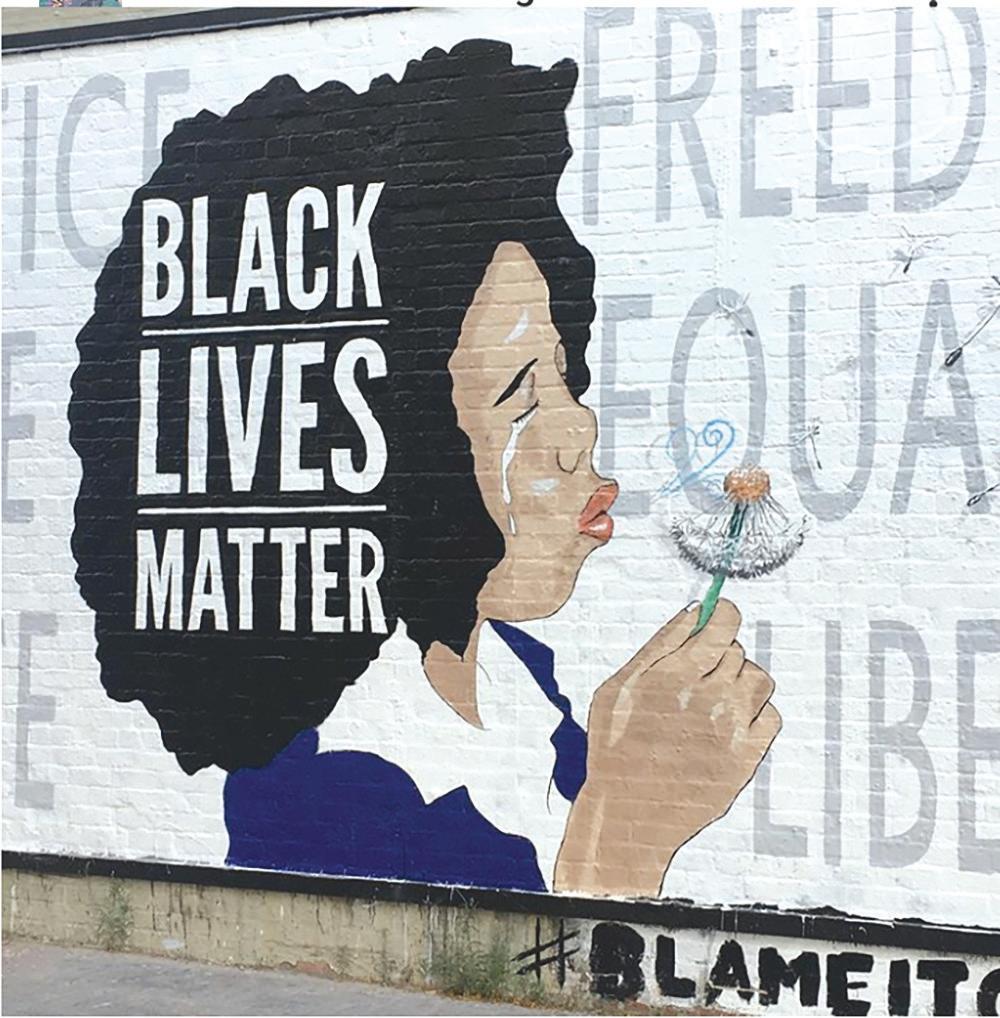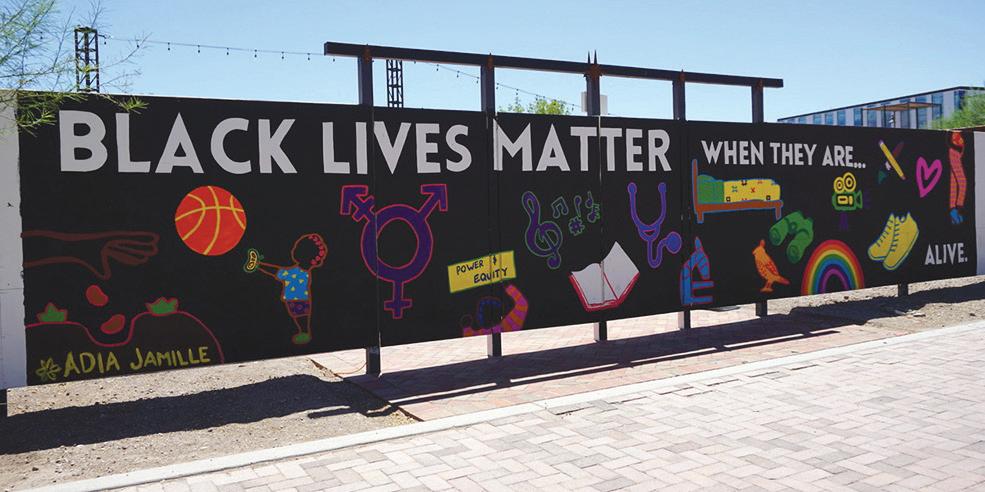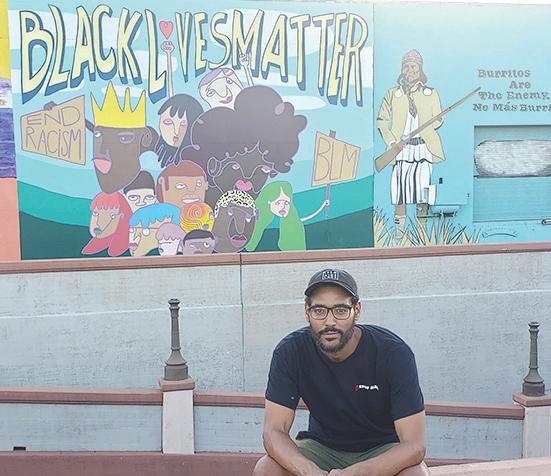
10 minute read
Lauren Valenzuela’s earrings are inspired by the desert
Murals for Change
Artists paint their support for Black Lives Matter
BY LAURA LATZKO
Following the deaths of George Floyd, Breonna Taylor, Dion Johnson and Ahmaud Arbery, people around the world are protesting for justice, equal treatment, and restructuring and retraining of police departments and redistribution of funding into communities.
Those who support the Black Lives Matter movement, which officially started in 2013, have found different ways to express themselves.
In Tucson, artists have used public murals to protest.
Some artists have created individual murals, while others have participated in group projects.
Through their pieces, they hope to inspire change and spark multifaceted discussions.
Camila Ibarra
Camila Ibarra wanted to make a statement about the COVID-19 pandemic and the Black Lives Matter movement with her Black Lives Matter mural on Hotel Congress.
Her work depicts a woman in a mask with the words “Black Lives Matter” painted into her hair and fists raised in protests behind her.
Ibarra completed the mural in two days. She brought her own painting supplies, and the Hotel Congress provided her with a wall space.
Ibarra says the woman in her mural represents the fortitude and perseverance of those protesting during the COVID-19 pandemic.
The mural felt personal to her as a supporter of the Black Lives Matter movement.
“When I was painting it, it meant a lot to me, so I was really emotional when I was painting it. I was hoping that I would be able to portray that emotion through my mural,” Ibarra says.
She was inspired by a picture of a pow erful-looking woman she saw on the internet, but she added her own interpretation. Ibarra says the response has surprised her. “It’s crazy how many different perspectives I’ve gotten to hear about that mural,” Ibarra says. “I didn’t expect it to impact people the way that it did.” Ibarra sold T-shirts and prints of her work to raise money for bailout funds for individuals ar rested during protests and for scholarships for people of color. She was able to raise thousands of dollars toward the local causes. This is Ibarra’s first public mural, but she painted several for Sahuaro High School as a teen and a sports-themed one at a Tempe boxing gym. She developed an interest in art during her freshman year in high school and later took an Advanced Placement art class her senior year. She has experience in drawing, painting and doing portraits.
Ibarra has been able to pursue multiple passions in her life at the same time, as she is studying engineering at ASU while doing art commissions as a side job.
Ibarra is part of the American Society of Civil Engineers’ ASU chapter, where she is able to use her engineering and artistic knowledge.
“They rely on me a lot to do art because they know I’m the artist in the group,” Ibarra says. “I definitely get to be very hands-on there and take on a leadership position.”

Downtown Mural Project
A number of artists painted murals in Downtown Tucson as part of a project organized by Joe Pagac, a local muralist.
Although Pagac doesn’t usually do politically driven or controversial projects, he felt it was important to get involved.
Pagac was originally going to do the murals himself but decided it was important to include an African American artist in the project.
“What was originally going to be me going out and painting these walls very quickly evolved into trying to get some of the Black artists in town who haven’t had as many opportunities to get walls or haven’t had any opportunities to paint murals to paint these walls,” Pagac says. He put out a call for artists and supplies on Facebook. The muralists painted on walls in various Downtown Tucson spaces. The muralists come from different backgrounds and levels of experience. They were given the freedom to be creative, with the only connecting thread being the words “Black Lives Matter.”
Participating artists included Nolan Patterson, Adia Jamille, Robbie Lee Harris and To-Ree-Nee Wolf.
For the artists involved, it was important to lend their abilities, voices and platforms to the cause.
“It was a way that I could offer something to the moment. It was something that I could be a part of in a larger way. I could offer my creativity and my skills to witness this profound moment,” Wolf says.
For a mural at the Rialto Theatre, Harris represented a young woman who is crying, blowing on a dandelion and wishing for equality. Around her, he painted the words “Justice,” “Love,” “Peace,” “Freedom,” “Equality” and “Liberty.”
“Just from being born, those six words should automatically apply to you. We unfortunately live in a society where those scales are not even,” Harris says.
Harris was inspired by the women in his life—his aunts, mother and sister, and his two daughters. Murals...continues on page 7

To-Ree-Nee Wolf’s Black Lives Matter mural adorns the MSA Annex. (Photo courtesy To-Ree-Nee Wolf) Murals...continued from page 6
“To have her up there and for my daughters to be able to see it, my mother to be able to see her, that resonated most with me,” Harris says.
Harris works as an EMT and pursues art as a hobby/side job. He started drawing around age 5 and later got into other art forms, such as woodburning and glass etching.
In two years, the Black Lives Matter mural has been one of his largest murals. Others were at elementary schools, a church and friends’ homes.
After installing the Black Lives Matter mural, Harris received many positive messages from people touched by his work, including people visiting Tucson from places such as New York.
“It’s an honor and humbling. I still don’t have the words. I still can’t express how cool that is having that image up there, and the impact that it has had,” Harris says. “People have been messaging me, saying they appreciate it. Seeing mothers with their daughters out there, people with tears. It hasn’t just been African American people that have had a positive or emotional response. … That was the impact that I wanted to have. I just wanted people to feel something from seeing it.”
Jamille and Wolf both painted at the MSA Annex.
In her piece, Jamille represented Black Lives Matter when they are pursuing different activities, including playing basketball, sleeping, making movies and music, watching birds, running and creating art. She also touched on the importance of the lives of LGBTQ and transgender people of color.
Her mural ends with the word “alive,” sending the message is that Black lives have value when they are allowed to live.
This was the fi rst time that Jamille, a fi - ber artist, has created a mural. She used a www.LovinLife.com similar style as her embroidery within her public art piece.
While she was painting her mural, her 11-year-old son and husband were there to assist. She says it was important to emphasize the value of Black lives.
“Some people say it as a buzz word, but for me, our lives matter. The lives we are living matter. That is where I ended up going with it, is focusing on the living part and thinking about what was happening to people who were assaulted or killed by the police or who have been threatened to have the police called on them,” Jamille says.
Jamille says for her, it was important to ultimately send a positive, uplifting message with her mural.
“Black life is colorful. It’s vibrant. It’s full of joy and happiness. I just wanted to translate that into the mural.”
She has presented her work locally at the Black Renaissance Festival, a space that highlights African American artists.
Her family’s background is in the arts, specifi cally her mothers who quilted.
Jamille, who often does screen printing and hand painting in her work, says her love of fi ber arts stems from being able to continually try something new.
“Every time I dye something, it’s going to be diff erent. Every time I print something, it’s going to be diff erent. When I embroider, it’s going to be diff erent. It’s always an experiment,” Jamille says.
Wolf worked on two sections as part of one piece, which represents African American people of diff erent ages.
One section features the words “Remember My” and “Name.” The other incorporates the American symbols of stars and stripes as well as ravens.
A guitarist, singer and actress, Wolf has been creating murals for almost 30 years. She studied illustration and painting at the Philadelphia College of Art and also does tile mosaic pieces. She was interested in art from a young age and grew up in an artistic household where her mother encouraged her to explore art.
In 2016, she created a piece called “Creation Story, Chaos Theory and Quantum Memory,” which touched on the topic of inclusivity. She did this piece around the same time as the protests over the Dakota Access Pipeline and the Dallas police offi - cer shooting.
Wolf says although her public art projects often address larger community issues, the Black Lives Matter piece felt different because of the state of the world.
“There’s always been a huge witnessing community component to what I do. This felt even larger than that because of this alchemical place that we are in, not only in our country but globally as well. I was very glad to be a part of this moment,” Wolf says.
She says this mural, in particular, had a very personal meaning to her.
“I know what it’s like to be an African American in America because I’ve dealt with that all of my life. I know what it’s like to have my life saved by the police, and I know what it’s like to have my life threatened by the police,” Wolf says. “I know what it’s like to be terrorized by white America. I’ve had two houses burned down on me. I also know what it’s like to be cherished by people of all ethnicities, to see my value, love me and allow me the great gift of loving them back. All I had to do was get in touch with my own feelings, my own history in this country and my own experiences in this country.”
Patterson created his mural, which was the last to be fi nished in the series, on a wall at Sixth and Toole avenues.
In his piece, he represented individuals of diff erent races coming together in protest, carrying signs such as “BLM” and “End Racism.” The mural fi ts with Patterson’s abstract art style.
He has been creating artwork since age 5 and has worked in diff erent mediums, including drawing, painting and mixed media.
His artwork was recently on display at Hotel McCoy and Gallery.
Creating murals is new for Patterson.
The artist has worked with Pagac in the past on murals, but the Black Lives Matter piece is the fi rst he’s done on his own. He was helped by his girlfriend, who is a crochet and textile artist.
He says completing the mural gave him an immense sense of accomplishment.
“There were lots of great emotions standing back and looking at it done for the fi rst time,” Patterson says.
His mural has been interactive in a way he didn’t expect. One woman, for example, took a photo with the mural so it looked like she was holding one of the protest signs.
“That’s the idea behind the diff erent characters in the mural. It represents everybody that connects with this movement,” Patterson says.


Nolan Patterson painted his Black Lives Matter mural at the corner of Sixth and Toole avenues. (Photo courtesy Nolan Patterson)







